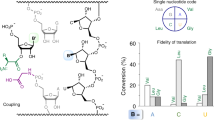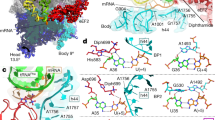Abstract
IN contrast to prokaryotic systems, initiation by eukaryotic ribosomes seems to be restricted to a single site near the 5′-terminus of the message. However, nucleotide sequence analyses have not revealed a common ‘recognition sequence’ within the 5′-proximal portion of eukaryotic messages. We have previously suggested that the position of an AUG codon within a eukaryotic message—rather than the surrounding nucleotide sequence—might be the primary feature defining an initiation site. We proposed1,2 that a 40S ribosomal subunit binds initially at or near the 5′-end of a message and migrates along the RNA chain until the first AUG codon is encountered, whereupon it stops, a 60S subunit joins, and polypeptide synthesis begins. Although this mechanism accounts for many of the peculiarities of eukaryotic translational initiation, it leaves unanswered the question of how ribosomes recognise the 5′-terminus of mRNA. The m7G cap which blocks the end of most eukaryotic messages3 is not, responsible for directing ribosomes to the 5′-terminus since ribosomes initiate at the 5′-proximal AUG even in uncapped or unmethylated RNAs4,5. The ability of ribosomes to select the 5′-end of a message irrespective of its chemical structure (that is, whether the terminus is m7GpppN…, GpppN… or pppN…) is difficult to explain. An intriguing possibility is that eukaryotic ribosomes attach to mRNA by a threading mechanism. A simple prediction of the threading mechanism is that circularisation of a message should abolish its ability to interact with ribosomes. The experiments described below fulfill this prediction. The possibility of threading by prokaryotic ribosomes was ruled out, several years ago, by the demonstration that Escherichia coli ribosomes were able to translate the circular DNA of phage fd6,7. Indeed, the simplest version of a threading mechanism (entry at the 5′-terminus of a message with translation beginning at the first AUG codon encountered by the ribosome) is contradicted by the ability of E. coli ribosomes to initiate at multiple internal sites in poly-cistronic messages, such as bacteriophage R17 RNA. Conversely, the threading mechanism is consistent with the mono-cistronic character of eukaryotic messages.
This is a preview of subscription content, access via your institution
Access options
Subscribe to this journal
Receive 51 print issues and online access
$199.00 per year
only $3.90 per issue
Buy this article
- Purchase on Springer Link
- Instant access to full article PDF
Prices may be subject to local taxes which are calculated during checkout
Similar content being viewed by others
References
Kozak, M. Cell 15, 1109–1123 (1978).
Kozak, M. & Shatkin, A. J. J. biol. Chem. 253, 6568–6577 (1978).
Shatkin, A. J. Cell 9, 645–653 (1976).
Kozak, M. & Shatkin, A. J. Cell 13, 201–212 (1978).
Leung, D. W., Browning, K. S., Heckman, J. E., RajBhandary, U. L. & Clark, J. M. Jr Biochemistry 18, 1361–1366 (1979).
Bretscher, M. S. Nature 220, 1088–1091 (1968).
Bretscher, M. S. J. molec. Biol. 42, 595–598 (1969).
Silber, R., Malathi, V. G. & Hurwitz, J. Proc. natn. Acad. Sci. U.S.A. 69, 3009–3013 (1972).
Singer, M. F. & Guss, J. K. J. biol. Chem. 237, 182–189 (1962).
Kozak, M. & Shatkin, A. J. J. biol. Chem. 251, 4259–4266 (1976).
Thach, R. E. & Doty, P. Science 147, 1310–1311 (1965).
Bruce, A. G. & Uhlenbeck, O. C. Nucleic Acids Res. 5, 3665–3677 (1978).
Kozak, M. & Shatkin, A. J. Meth. Enzymol. 60, 360–375 (1979).
Subramanian, A. R. Biochemistry 11, 2710–2714 (1972).
Author information
Authors and Affiliations
Rights and permissions
About this article
Cite this article
KOZAK, M. Inability of circular mRNA to attach to eukaryotic ribosomes. Nature 280, 82–85 (1979). https://doi.org/10.1038/280082a0
Received:
Accepted:
Issue Date:
DOI: https://doi.org/10.1038/280082a0
Comments
By submitting a comment you agree to abide by our Terms and Community Guidelines. If you find something abusive or that does not comply with our terms or guidelines please flag it as inappropriate.



